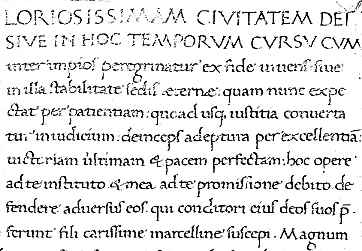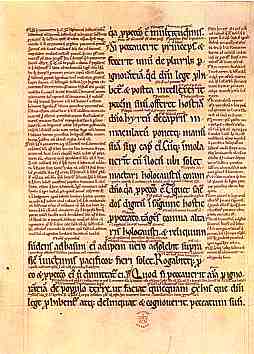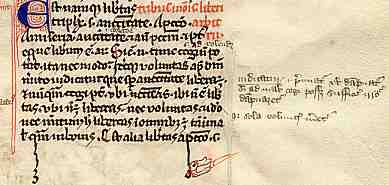




If you are looking at this page without frames, there is more information about medieval writing to be found by going to the home page (framed) or the site map (no frames).
| The Concept of Text in the Manuscript Tradition (2) | ||||
| Also copied out slavishly in monastic scriptoria in the early centuries of the expanding church were the works of the early church fathers, known as the patristic writers. As the church in those early years, and for centuries after for that matter, was deeply engaged in combatting heresy by demanding conformity of interpretation of Biblical texts, which themselves could be both terse and enigmatic at times, these works provided the basis for acceptable conformist interpretation. Some of these works were recopied in what was at least intended to be unchanged form over centuries and generations of copies. | ||||
 |
A grab from the beginning of St Augustine's De Civitate Dei, copy from before 1485 from Italy, probably Naples (British Library, add.ms. 15246, f.29). (From The New Palaeographical Society, 1911) | |||
| This work retained its popularity through the centuries of Christianity, always appearing to have some relevance as Europe was overwhelmed by more disasters and gloomy forebodings. | ||||
| These patristic works did not remain as static texts, however. From the days of Isidore of Seville in the 6th century onwards, they were studied and reworked into larger compilations. The medieval tradition of scholarship was rooted in the concept of authoritative pre-existing texts. This did not mean that nobody was ever allowed to have a new thought, but any new thoughts had to be shown to spring from existing authority. This may not be so far distant from the writing of a modern PhD thesis, except that instead of footnotes and a bibliography, the text contained the words of its progenitors. Old texts were woven together into complex webs with new ideas. Scholarly texts were organic and evolving, but constrained by the existing literate tradition. | ||||
 |
A litle grab from an 8th century copy of Isidore's Etymologiae, originating from the monastery of Bobbio (Milan, Biblioteca Ambrosiana, L.99, parte superiore, p.35). (From Steffens 1929) | |||
 |
Compilations from patristic works were assembled for incorporation into volumes of the Bible, in the form of the gloss, a continuous running commentary that surrounded and infiltrated the text. The core text was unchanged, but it was set within the tradition of additive content derived from authoritative sources. The gloss itself became a standard text, being so much a part of the Bible that it could not be allowed to get individual or creative. With the complicated page layout, generational copying became a complex task. Nevertheless, even this ultimate text was not entirely immune to the medieval attitude to text as organic. | |||
| Glossed copy of the Book of Leviticus and the Gospel of St John, from St Mary's Abbey, Buildwas in 1176, now in the British Library. (From M.R. James 1925 Abbeys London: The Great Western Railway) | ||||
| The concept of glosses was built into many scholarly works. Books for study often had pages in which the main text was constrained into a small space by the use of small crammed scripts and extensive abbreviation, leaving wide margins for the reader to add their own notes and glosses. In many university texts, the glosses of important scholars became part of the work, laid out in a similar way to the glossed Bible. The reader became a contributory writer and the text became a composite entity. | ||||
 |
A sample from a 14th century copy of the Sentences of Petrus Lombardus, with informally added gloss. From a private collection. | |||
| In this example the gloss is added in a different script to that of the main text, and apparently emphasised with a little dog's head pointer. | ||||
 |
Page segment from a late 15th century printed legal text, from a private collection. | |||
| This example from the early days of printing shows the main text at left, formal gloss included in the printed text at right, and some informally added manuscript gloss at bottom right. | ||||
| So far we have been looking at text as a process of compilation, but it is actually not so simple as this. | ||||
| |
||||
If you are looking at this page without frames, there is more information about medieval writing to be found by going to the home page (framed) or the site map (no frames). |
||||